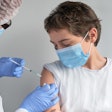
Researchers used an enzyme-linked immunosorbent assay (ELISA) blood test to assess immune response in people exposed to the H1N1 influenza A virus and found that those who produced certain types of antibodies were less likely to become infected. The study could lead to the development of more effective flu vaccines.
The researchers focused on 88 people in Nicaragua who were confirmed to be infected with pandemic H1N1 influenza A virus, as well as 300 people in their households who had contact with those infected. The investigators first used the ELISA blood test to measure pre-existing levels of antibodies produced against hemagglutinin (HA), a mushroom-shaped protein found on the surface of the influenza virus that is key to its infectivity. They then obtained additional blood samples 30 to 45 days later and acquired nasal and throat swabs to track who became infected with the flu virus.
 Colorized transmission electron micrograph showing H1N1 influenza virus particles. Surface proteins on the virus particles are shown in black. Image courtesy of NIAID.
Colorized transmission electron micrograph showing H1N1 influenza virus particles. Surface proteins on the virus particles are shown in black. Image courtesy of NIAID.In particular, the researchers focused on antibodies produced against the stem of the hemagglutinin protein, which is less visible than the HA head. The HA head is the region targeted by current seasonal influenza vaccines, as well as by standard laboratory tests used to examine immune response to particular influenza strains.
In all, 28% of the 300 household contacts became infected with the influenza virus, and 63% of those who were infected developed influenza symptoms. The ELISA results revealed that individuals who had higher levels of HA stem antibodies at the beginning of the study were less likely to become infected with the flu virus.
The findings indicate that the level of HA stem antibodies could be used as a correlate to determine a person's level of protection against the flu. The results support the development of vaccine candidates targeting the HA stem, according to the researchers.
The study was published in Nature Medicine on June 3 and was funded by the U.S. National Institute of Allergy and Infectious Diseases (NIAID), part of the National Institutes of Health.
The study group included investigators from the University of Michigan, the Icahn School of Medicine at Mount Sinai, and St. Jude Children's Research Hospital, along with researchers in Nicaragua who conducted field work.




_400.png?auto=format%2Ccompress&fit=crop&h=167&q=70&w=250)














